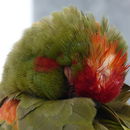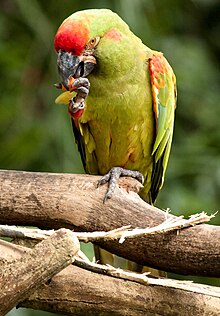en
names in breadcrumbs


Red-fronted macaws have been considered a nuisance to farmers in Bolivia. Since corn is the main source of food in the red-fronted macaw diet, many crops are affected by their presence. This is detrimental to the production of corn for the farmers who depend on this crop.
Negative Impacts: crop pest
Attacks by peregrine falcons have been documented. Flocking behavior is often considered an anti-predator mechanism. Red-fronted macaws often form flocks of 2 to 30 individuals, and will simultaneously fly up in alarm when raptors are near. This makes it difficult for a predator to pick out and successfully attack one individual.
Known Predators:
Red-fronted macaws are a smaller macaw species with an average length of 60 cm (24 in) and an average wingspan of 81.28 cm (32 in). They are the lightest macaw, weighing in between 425 to 550 grams. Red-fronted macaws are predominately green in color with red patches on the forehead, shoulders, and behind the eyes. Primary feathers are a striking teal-blue, while the tail ranges from green to teal-blue as well. Red-fronted macaws have pale skin located around the eye. Male and females look alike in coloration. Juvenile red-fronted macaws have all green heads and begin to show red coloration between six to twelve months of age. Their wings are entirely green and they exhibit only some red feathers around the thigh area.
Range mass: 425 to 550 g.
Average length: 60 cm.
Average wingspan: 81.28 cm.
Other Physical Features: endothermic ; homoiothermic; bilateral symmetry
Sexual Dimorphism: sexes alike
Red-fronted macaws may live up to 50 years. Many pet resources report the birds to live upwards of 25 years.
Typical lifespan
Status: wild: 50 (high) years.
Typical lifespan
Status: captivity: 25 (low) years.
Red-fronted macaws live in the warm, dry valleys of Bolivia. Due to low annual rainfall of 300 to 800 mm, the vegetation is primarily thorny-scrub with a variety of cacti. Red-fronted macaws nest in cavities of river-side canyons and gorges
Habitat Regions: tropical ; terrestrial
Terrestrial Biomes: desert or dune ; savanna or grassland
Other Habitat Features: agricultural
Red-fronted macaws (Ara rubrogenys) are endemic to the arid valleys of south-central Bolivia, South America. They range from south Cochabamba and west Santa Cruz through north Chuquisaca to north-east Potosí in Bolivia. The largest populations of red-fronted macaws are in the valleys of Ríos Grande, Mizque and Pilcomayo.
Biogeographic Regions: neotropical (Native )
Red-fronted macaws mostly feed on vegetation, vegetables, fruit and nuts. Fruits of trees such as Jatropha hieronymii are the main source of nutrition. Most grasses found in the Bolivia valleys are also consumed. Cacti (Cereus) are included in the diet and serve as a source of both food and water in their arid habitat. Like many macaws, they often chew on sticks or tree bark. As a result of habitat destruction for agriculture, grazing, or firewood there are fewer native food sources available and the birds have turned to cultivated crops. The preferred crop is corn, as the birds will invest hours of time in evading farmer's attempts to ward them off.
Plant Foods: leaves; wood, bark, or stems; seeds, grains, and nuts; fruit; flowers
Primary Diet: herbivore (Frugivore , Granivore )
Red-fronted macaws have a mutualistic relationship with cacti in the area. Since both macaw and cactus are limited to the same arid environment, macaws are an effective seed dispersant. After Red-fronted Macaws eat cacti fruits, the seeds are excreted unharmed and are distributed throughout the valley, thus supporting the population of the cactus. Red-fronted macaws also inadvertently pollinate some plants while foraging.
Ecosystem Impact: disperses seeds; pollinates
Mutualist Species:
Red-fronted macaws help pollinate some plants in the Bolivia area to preserve its beautiful botanical communities. Their playful, affectionate, and curious personalities in captivity are increasing their popularity as a household pet. Thanks to captive breeding they are becoming more readily available for the pet trade.
Positive Impacts: pet trade
Since 1991, the population of red-fronted macaws has been on the decline. They are listed as endangered on the IUCN Red List. They are endemic to a very small range in Bolivia, and with increasing habitat destruction their natural food sources are becoming increasingly rare. Red-fronted macaws then turn to human agriculture, mainly corn, for sustenance. Many farmers perceive the birds as pests and utilize firearms or traps to protect their crops. As of 2009, the population estimate has ranged from 4,000 to as low as 1,000 red-fronted macaws in the Bolivia Valley area.
CITES: appendix i
IUCN Red List of Threatened Species: endangered
Red-fronted macaws produce loud vocalizations when communicating. They are intelligent and can learn how to speak and whistle in addition to having a boisterous squawk. They have two distinct vocalizations known as quiet twitter-vocalizations and alert-vocalizations. Quiet twitter-vocalization occur between partners. The calls between the pair begin with a loud squawk and decline into a soft coo and chuckle. Alert-vocalizations are given in response to predators in the area and consist of loud vocalization for long intervals. Juveniles have a softer, yet higher pitch call which is still used by adults.
Red-fronted macaws utilize many tactile forms of communication, mainly between pairs. Pairs often perform allopreening (mutual preening), beak grabbing, or nibbling of facial feathers throughout the year to maintain pair bonds.
The social flocking behavior of red-fronted macaws may suggest that flocks are an information hub where individuals can share knowledge such as good foraging locations. Flocks also exhibit social facilitation where one individual starts a behavior, such as a particular vocalization, which is quickly mimicked and spread throughout the flock. This behavior is suggested to support group cohesion and reduce aggression among group members.
Red-fronted macaws perceive their environment through visual, auditory, tactile, and chemical stimuli.
Communication Channels: visual ; tactile ; acoustic
Other Communication Modes: mimicry
Perception Channels: visual ; tactile ; acoustic ; chemical
Red-fronted macaws form monogamous pair-bonds that are maintained year-round. Even outside of the breeding season, copulation and preening occur exclusively between pairs presumably to maintain their bond. Pairs also exhibit caressing behaviors defined by nibbling face feathers or grasping beaks. Since both the male and female are similar in color and size, sexual dimorphism is not the basis of mate selection.
Mating System: monogamous
Red-fronted macaws breed once a year between October and March. They nest in cavities on angled cliff sides of narrow, rocky gorges. Nests are comprised mainly of sandstone. They lay 1 to 3 eggs per season and incubation is around 26 days.
Breeding interval: Red-fronted Macaws breed once yearly.
Breeding season: Red-fronted Macaws breed from October to March.
Range eggs per season: 1 to 3.
Average time to hatching: 26 days.
Key Reproductive Features: iteroparous ; seasonal breeding ; gonochoric/gonochoristic/dioecious (sexes separate); sexual ; oviparous
Observations have shown that both parents tend the nest, but time spent in the nest varies in each pair. After young hatch, parents spend most of their time in the nest. Post-fledging, juveniles join a flock with their parents. Many social activities occur within the flock, but the majority of interactions occur within members of the same 'family' (parent-parent, parent-juvenile, juvenile-juvenile).
Parental Investment: altricial ; male parental care ; female parental care ; pre-fertilization (Provisioning, Protecting: Female); pre-hatching/birth (Provisioning: Male, Female, Protecting: Male, Female); pre-weaning/fledging (Provisioning: Male, Female, Protecting: Male, Female); pre-independence (Provisioning, Protecting); post-independence association with parents
The red-fronted macaw (Ara rubrogenys) is a parrot endemic to a small semi-desert mountainous area of Bolivia. It is a critically endangered species; it has been successfully bred in captivity, and is available, if not common, as a pet. It is also sometimes known in the literature as Lafresnaye's macaw, named for the French ornithologist Frédéric de Lafresnaye, who was one of the first to describe the species.[3]
The red-fronted macaw is 55–60 cm (21.5–23.5 in) long. It is mostly green, and has a red forehead, a red patch over the ears and bright red to orange edged under wing coverts. It has an area of pinkish skin around the eyes extending to the beak. It has red at the bend of wings and blue primary wing feathers.
The red-fronted macaw is native to a small mountainous area of south-central Bolivia situated about 200 km west of Santa Cruz, in the department of the same name, where the climate is medium altitude semi-desert. The natural vegetation consists mostly of cactus (large and small) and thorny trees and scrub. The climate is semi arid with cold nights and hot days. Rain comes in infrequent heavy storms. It is unusual in that it is the only macaw to inhabit such a climatic zone. Most macaws nest in holes in large trees, however here there are no very large trees in its range so it nests in vertical fissures in cliff faces.[4] The bird has been captured for the pet trade in the past and killed by local farmers because it raids their crops.

Side – Jurong BirdPark, Singapore
The red-fronted macaw (Ara rubrogenys) is a parrot endemic to a small semi-desert mountainous area of Bolivia. It is a critically endangered species; it has been successfully bred in captivity, and is available, if not common, as a pet. It is also sometimes known in the literature as Lafresnaye's macaw, named for the French ornithologist Frédéric de Lafresnaye, who was one of the first to describe the species.